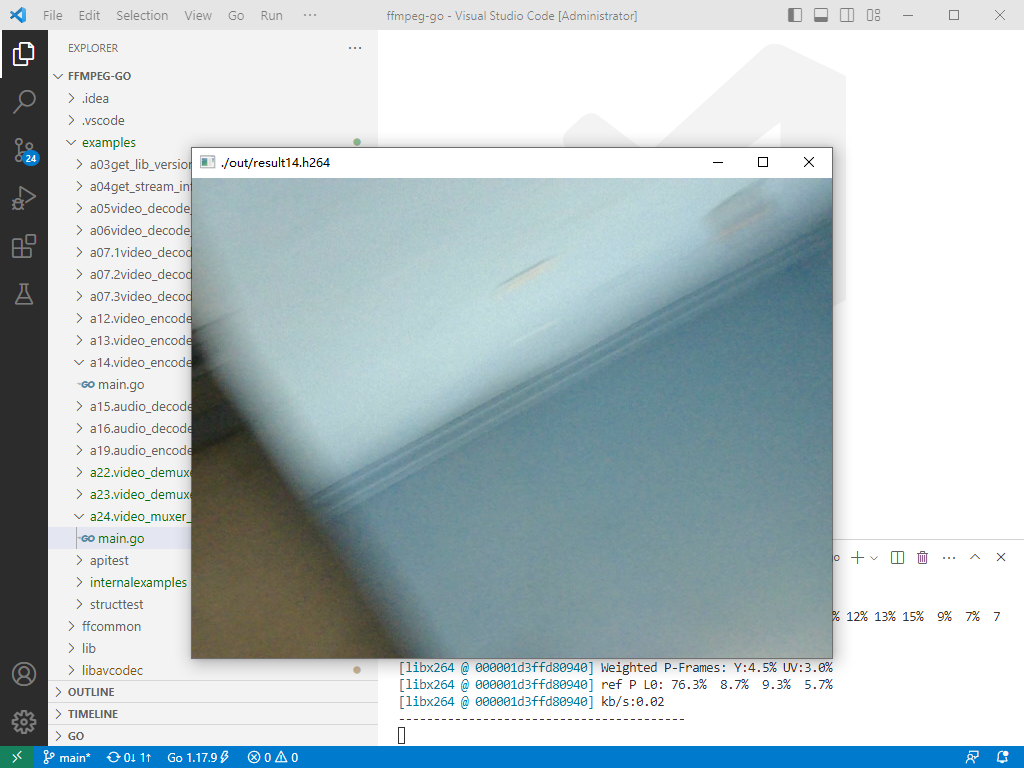2023-03-03:请用go语言调用ffmpeg,摄像头捕获并编码为h264文件,不管音频。
2023-03-03:请用go语言调用ffmpeg,摄像头捕获并编码为h264文件,不管音频。
答案2023-03-03:
使用 github.com/moonfdd/ffmpeg-go 库。
先用如下命令,获取摄像头的名称。此摄像头名称是"Full HD webcam",你们需要修改代码,把名称给改了。
./lib/ffmpeg -list_devices true -f dshow -i dummy

代码命令如下:
go run ./examples/a14.video_encode_camera2h264/main.go
参考了14:摄像头捕获并编码为h264,代码用golang编写。代码如下:
package main
import (
"fmt"
"os"
"os/exec"
"time"
"unsafe"
"github.com/moonfdd/ffmpeg-go/ffcommon"
"github.com/moonfdd/ffmpeg-go/libavcodec"
"github.com/moonfdd/ffmpeg-go/libavdevice"
"github.com/moonfdd/ffmpeg-go/libavformat"
"github.com/moonfdd/ffmpeg-go/libavutil"
"github.com/moonfdd/ffmpeg-go/libswscale"
)
func main() {
// ./lib/ffmpeg -list_devices true -f dshow -i dummy
// ./lib/ffplay -f dshow -i video="Full HD webcam"
os.Setenv("Path", os.Getenv("Path")+";./lib")
ffcommon.SetAvutilPath("./lib/avutil-56.dll")
ffcommon.SetAvcodecPath("./lib/avcodec-58.dll")
ffcommon.SetAvdevicePath("./lib/avdevice-58.dll")
ffcommon.SetAvfilterPath("./lib/avfilter-56.dll")
ffcommon.SetAvformatPath("./lib/avformat-58.dll")
ffcommon.SetAvpostprocPath("./lib/postproc-55.dll")
ffcommon.SetAvswresamplePath("./lib/swresample-3.dll")
ffcommon.SetAvswscalePath("./lib/swscale-5.dll")
genDir := "./out"
_, err := os.Stat(genDir)
if err != nil {
if os.IsNotExist(err) {
os.Mkdir(genDir, 0777) // Everyone can read write and execute
}
}
// frame_index := 0 //统计帧数
// inVStreamIndex := -1
// outVStreamIndex := -1 //输入输出视频流在文件中的索引位置
// inVFileName := "./out/result.h264"
// outFileName := "./out/result.mp4"
//是否存在h264文件
// _, err = os.Stat(inVFileName)
// if err != nil {
// if os.IsNotExist(err) {
// fmt.Println("create h264 file")
// exec.Command("./lib/ffmpeg", "-i", "./resources/big_buck_bunny.mp4", "-vcodec", "copy", "-an", inVFileName, "-y").CombinedOutput()
// }
// }
ret := int32(0)
libavdevice.AvdeviceRegisterAll()
inFmtCtx := libavformat.AvformatAllocContext()
var inCodecCtx *libavcodec.AVCodecContext
var inCodec *libavcodec.AVCodec
inPkt := libavcodec.AvPacketAlloc()
srcFrame := libavutil.AvFrameAlloc()
yuvFrame := libavutil.AvFrameAlloc()
//打开输出文件,并填充fmtCtx数据
outFmtCtx := libavformat.AvformatAllocContext()
var outFmt *libavformat.AVOutputFormat
var outCodecCtx *libavcodec.AVCodecContext
var outCodec *libavcodec.AVCodec
var outVStream *libavformat.AVStream
outPkt := libavcodec.AvPacketAlloc()
var img_ctx *libswscale.SwsContext
inVideoStreamIndex := -1
for {
/解码器部分//
//打开摄像头
inFmt := libavformat.AvFindInputFormat("dshow")
if libavformat.AvformatOpenInput(&inFmtCtx, "video=Full HD webcam", inFmt, nil) < 0 {
fmt.Printf("Cannot open camera.\n")
return
}
if inFmtCtx.AvformatFindStreamInfo(nil) < 0 {
fmt.Printf("Cannot find any stream in file.\n")
return
}
for i := 0; i < int(inFmtCtx.NbStreams); i++ {
if inFmtCtx.GetStream(uint32(i)).Codecpar.CodecType == libavutil.AVMEDIA_TYPE_VIDEO {
inVideoStreamIndex = i
break
}
}
if inVideoStreamIndex == -1 {
fmt.Printf("Cannot find video stream in file.\n")
return
}
inVideoCodecPara := inFmtCtx.GetStream(uint32(inVideoStreamIndex)).Codecpar
inCodec = libavcodec.AvcodecFindDecoder(inVideoCodecPara.CodecId)
if inCodec == nil {
fmt.Printf("Cannot find valid video decoder.\n")
return
}
inCodecCtx = inCodec.AvcodecAllocContext3()
if inCodecCtx == nil {
fmt.Printf("Cannot alloc valid decode codec context.\n")
return
}
if inCodecCtx.AvcodecParametersToContext(inVideoCodecPara) < 0 {
fmt.Printf("Cannot initialize parameters.\n")
return
}
if inCodecCtx.AvcodecOpen2(inCodec, nil) < 0 {
fmt.Printf("Cannot open codec.\n")
return
}
img_ctx = libswscale.SwsGetContext(inCodecCtx.Width,
inCodecCtx.Height,
inCodecCtx.PixFmt,
inCodecCtx.Width,
inCodecCtx.Height,
libavutil.AV_PIX_FMT_YUV420P,
libswscale.SWS_BICUBIC,
nil, nil, nil)
numBytes := libavutil.AvImageGetBufferSize(libavutil.AV_PIX_FMT_YUV420P,
inCodecCtx.Width,
inCodecCtx.Height, 1)
out_buffer := libavutil.AvMalloc(uint64(numBytes))
ret = libavutil.AvImageFillArrays((*[4]*ffcommon.FUint8T)(unsafe.Pointer(&yuvFrame.Data)),
(*[4]ffcommon.FInt)(unsafe.Pointer(&yuvFrame.Linesize)),
(*ffcommon.FUint8T)(unsafe.Pointer(out_buffer)),
libavutil.AV_PIX_FMT_YUV420P,
inCodecCtx.Width,
inCodecCtx.Height,
1)
if ret < 0 {
fmt.Printf("Fill arrays failed.\n")
return
}
//解码器部分结束/
//编码器部分开始/
outFile := "./out/result14.h264"
if libavformat.AvformatAllocOutputContext2(&outFmtCtx, nil, "", outFile) < 0 {
fmt.Printf("Cannot alloc output file context.\n")
return
}
outFmt = outFmtCtx.Oformat
//打开输出文件
if libavformat.AvioOpen(&outFmtCtx.Pb, outFile, libavformat.AVIO_FLAG_READ_WRITE) < 0 {
fmt.Printf("output file open failed.\n")
return
}
//创建h264视频流,并设置参数
outVStream = outFmtCtx.AvformatNewStream(outCodec)
if outVStream == nil {
fmt.Printf("create new video stream fialed.\n")
return
}
outVStream.TimeBase.Den = 30
outVStream.TimeBase.Num = 1
//编码参数相关
outCodecPara := outFmtCtx.GetStream(uint32(outVStream.Index)).Codecpar
outCodecPara.CodecType = libavutil.AVMEDIA_TYPE_VIDEO
outCodecPara.CodecId = outFmt.VideoCodec
outCodecPara.Width = 480
outCodecPara.Height = 360
outCodecPara.BitRate = 110000
//查找编码器
outCodec = libavcodec.AvcodecFindEncoder(outFmt.VideoCodec)
if outCodec == nil {
fmt.Printf("Cannot find any encoder.\n")
return
}
//设置编码器内容
outCodecCtx = outCodec.AvcodecAllocContext3()
outCodecCtx.AvcodecParametersToContext(outCodecPara)
if outCodecCtx == nil {
fmt.Printf("Cannot alloc output codec content.\n")
return
}
outCodecCtx.CodecId = outFmt.VideoCodec
outCodecCtx.CodecType = libavutil.AVMEDIA_TYPE_VIDEO
outCodecCtx.PixFmt = libavutil.AV_PIX_FMT_YUV420P
outCodecCtx.Width = inCodecCtx.Width
outCodecCtx.Height = inCodecCtx.Height
outCodecCtx.TimeBase.Num = 1
outCodecCtx.TimeBase.Den = 30
outCodecCtx.BitRate = 110000
outCodecCtx.GopSize = 10
if outCodecCtx.CodecId == libavcodec.AV_CODEC_ID_H264 {
outCodecCtx.Qmin = 10
outCodecCtx.Qmax = 51
outCodecCtx.Qcompress = 0.6
} else if outCodecCtx.CodecId == libavcodec.AV_CODEC_ID_MPEG2VIDEO {
outCodecCtx.MaxBFrames = 2
} else if outCodecCtx.CodecId == libavcodec.AV_CODEC_ID_MPEG1VIDEO {
outCodecCtx.MbDecision = 2
}
//打开编码器
if outCodecCtx.AvcodecOpen2(outCodec, nil) < 0 {
fmt.Printf("Open encoder failed.\n")
return
}
///编码器部分结束
///编解码部分//
yuvFrame.Format = outCodecCtx.PixFmt
yuvFrame.Width = outCodecCtx.Width
yuvFrame.Height = outCodecCtx.Height
ret = outFmtCtx.AvformatWriteHeader(nil)
count := 0
for inFmtCtx.AvReadFrame(inPkt) >= 0 && count < 50 {
if inPkt.StreamIndex == uint32(inVideoStreamIndex) {
if inCodecCtx.AvcodecSendPacket(inPkt) >= 0 {
ret = inCodecCtx.AvcodecReceiveFrame(srcFrame)
for ret >= 0 {
if ret == -libavutil.EAGAIN || ret == libavutil.AVERROR_EOF {
break
} else if ret < 0 {
fmt.Printf("Error during decoding\n")
return
}
img_ctx.SwsScale((**byte)(unsafe.Pointer(&srcFrame.Data)),
(*int32)(unsafe.Pointer(&srcFrame.Linesize)),
0, uint32(inCodecCtx.Height),
(**byte)(unsafe.Pointer(&yuvFrame.Data)), (*int32)(unsafe.Pointer(&yuvFrame.Linesize)))
yuvFrame.Pts = srcFrame.Pts
//encode
if outCodecCtx.AvcodecSendFrame(yuvFrame) >= 0 {
if outCodecCtx.AvcodecReceivePacket(outPkt) >= 0 {
fmt.Printf("encode one frame.\n")
count++
outPkt.StreamIndex = uint32(outVStream.Index)
outPkt.AvPacketRescaleTs(outCodecCtx.TimeBase,
outVStream.TimeBase)
outPkt.Pos = -1
outFmtCtx.AvInterleavedWriteFrame(outPkt)
outPkt.AvPacketUnref()
}
}
// usleep(1000*24);
time.Sleep(time.Millisecond * 24)
ret = inCodecCtx.AvcodecReceiveFrame(srcFrame)
}
}
inPkt.AvPacketUnref()
}
}
ret = flush_encoder(outFmtCtx, outCodecCtx, int(outVStream.Index))
if ret < 0 {
fmt.Printf("flushing encoder failed.\n")
return
}
outFmtCtx.AvWriteTrailer()
编解码部分结束
break
}
///内存释放部分/
libavcodec.AvPacketFree(&inPkt)
libavcodec.AvcodecFreeContext(&inCodecCtx)
inCodecCtx.AvcodecClose()
libavformat.AvformatCloseInput(&inFmtCtx)
libavutil.AvFrameFree(&srcFrame)
libavutil.AvFrameFree(&yuvFrame)
libavcodec.AvPacketFree(&outPkt)
libavcodec.AvcodecFreeContext(&outCodecCtx)
outCodecCtx.AvcodecClose()
libavformat.AvformatCloseInput(&outFmtCtx)
fmt.Println("-----------------------------------------")
_, err = exec.Command("./lib/ffplay.exe", "./out/result14.h264").Output()
if err != nil {
fmt.Println("play err = ", err)
}
}
func flush_encoder(fmtCtx *libavformat.AVFormatContext, codecCtx *libavcodec.AVCodecContext, vStreamIndex int) int32 {
ret := int32(0)
enc_pkt := libavcodec.AvPacketAlloc()
enc_pkt.Data = nil
enc_pkt.Size = 0
if (codecCtx.Codec.Capabilities & libavcodec.AV_CODEC_CAP_DELAY) == 0 {
return 0
}
fmt.Printf("Flushing stream #%d encoder\n", vStreamIndex)
if codecCtx.AvcodecSendFrame(nil) >= 0 {
for codecCtx.AvcodecReceivePacket(enc_pkt) >= 0 {
fmt.Printf("success encoder 1 frame.\n")
// parpare packet for muxing
enc_pkt.StreamIndex = uint32(vStreamIndex)
enc_pkt.AvPacketRescaleTs(codecCtx.TimeBase,
fmtCtx.GetStream(uint32(vStreamIndex)).TimeBase)
ret = fmtCtx.AvInterleavedWriteFrame(enc_pkt)
if ret < 0 {
break
}
}
}
enc_pkt.AvPacketUnref()
return ret
}

2023-03-03:请用go语言调用ffmpeg,摄像头捕获并编码为h264文件,不管音频。的更多相关文章
- Unity3D中调用外接摄像头,并保存为图片文件
http://bbs.9ria.com/thread-170539-1-1.html 项目要求调用摄像头,并且把图像保存下来,上传到服务器. 这里有几个难点,调用摄像头是很简单的,unity已经提供好 ...
- 使用HTML5+调用手机摄像头和相册
前言:前端时间使用HTML5做了一个WEB端APP,其中用到了H5页面调用手机摄像头的功能,当时也是花了不少时间去研究.最终是采用了HTML5plus(HTML5+)的方式完成了该功能,现将具体方法简 ...
- 2019.03.03 - Linux搭建go语言交叉环境
编译GO 1.6版本以上的需要依赖GO 1.4版本的二进制,并且需要把GOROOT_BOOTSTRAP的路径设置为1.4版本GO的根目录,这样它的bin目录就可以直接使用到1.4版本的GO 搭建go语 ...
- Golang通过Thrift框架完美实现跨语言调用
每种语言都有自己最擅长的领域,Golang 最适合的领域就是服务器端程序. 做为服务器端程序,需要考虑性能同时也要考虑与各种语言之间方便的通讯.采用http协议简单,但性能不高.采用TCP通讯,则需要 ...
- Atitit java c# php c++ js跨语言调用matlab实现边缘检测等功能attilax总结
Atitit java c# php c++ js跨语言调用matlab实现边缘检测等功能attilax总结 1.1. 边缘检测的基本方法Canny最常用了1 1.2. 编写matlab边缘检测代码, ...
- Golang、Php、Python、Java基于Thrift0.9.1实现跨语言调用
目录: 一.什么是Thrift? 1) Thrift内部框架一瞥 2) 支持的数据传输格式.数据传输方式和服务模型 3) Thrift IDL 二.Thrift的官方网站在哪里? 三.在哪里下载?需要 ...
- Java跨语言调用,使用JNA访问Java外部接口
1. JNA简单介绍 先说JNI(Java Native Interface)吧,有过不同语言间通信经历的一般都知道,它允许Java代码和其他语言(尤其C/C++)写的代码进行交互,只要遵守调用约定即 ...
- 在VS2015中用C++编写可被其它语言调用的动态库DLL
转自:http://blog.csdn.net/songyi160/article/details/50754705 VS2015用C++创建动态库DLL步骤如下: (1)启动VS2015>文件 ...
- C语言调用Intel处理器CPUID指令的实例
C语言调用Intel处理器CPUID指令的实例 来源 https://blog.csdn.net/subfate/article/details/50789905 在Linux环境下,使用C语言内嵌汇 ...
- C/C++编程笔记:C语言入门知识点(三),请收藏C语言最全笔记!
今天我们继续来学习C语言的入门知识点,第一课:C/C++编程笔记:C语言入门知识点(二),请收藏C语言最全笔记! 21. 输入 & 输出 当我们提到输入时,这意味着要向程序填充一些数据.输入可 ...
随机推荐
- 插入Mybatis教学
------------恢复内容开始------------ 1.Mybatis的CRUD 首先第一点要注意: namespace中的包名称,一定要和mapper接口的包名称要一一对应. 有上面的图可 ...
- SQL 抽象语法树及改写场景应用
SQL 抽象语法树及改写场景应用 1 背景 我们平时会写各种各样或简单或复杂的 sql 语句,提交后就会得到我们想要的结果集.比如 sql 语句,"select * from t_user ...
- VSCode 开发Vue + ElementUI
参考 (1)VSCode 开发Vue + ElementUI (2)玩转VSCode-完整构建VSCode开发调试环境 (shuzhiduo.com) (3)使用vscode搭建vue项目并引用ele ...
- TCP粘包和拆包
假设客户端分别发送了两个数据包D1和D2给服务器,由于服务器一次读取的字节数是不确定的,故可能存在以下4中情况: 服务端分两次读到了两个独立的数据包D1和D2,没有粘包和拆包 服务端分一次收到两个数据 ...
- 关于windows cmd 控制台输出中文
由于中文在window 输出总是优乱码可能性 ,先建cmd.reg 负责下面内容 ,双击运行即可. Windows Registry Editor Version 5.00 [HKEY_CURR ...
- elementui中对样式的修改标签
/deep/ .el-drawer.rtl { -webkit-animation: rtl-drawer-out .3s; animation: rtl-drawer-out .3s; backgr ...
- Lucene搜索引擎-搜索
Lucene搜索引擎-搜索 常用的Query: BooleanQuery:多个条件组合查询,注意 new BooleanQuery().add(Query, BooleanClause.Occur); ...
- 重构SeleniumeDownloader底层浏览器驱动
一.解决bug:Selenium with PhantomJS,重构SeleniumeDownloader底层浏览器驱动 0.小背景: 想爬取外网steam的数据,但是steam官网在海外,加上ste ...
- PHP 文件和文件夹操作
文件夹操作 创建文件夹 mkdir(名称,权限,递归创建):创建文件 例如: #创建文件夹 mkdir('./aa') # 创建 aa 文件夹 mkdir('./aa/bb') # 在 aa 目录下创 ...
- Python学习笔记--异常+模块+包
异常的捕获 基本语法: 示例: 捕获指定异常 基本语法:--必写 示例: 捕获多个异常 示例: 捕获所有异常 示例: 异常else--可写可不写 示例: 异常finally(无论是否出现异常,都会去执 ...
